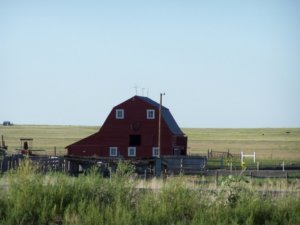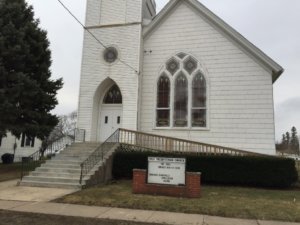Dr. Gordon E. Penfold
Co-founder of Turnaround Pastors, Inc.
The Two Barns
“It was the best of times and it was the worst of times . . ..” So begins Charles Dickens’, A Tale of Two Cities. I would like to parallel that truth with two barns and two churches. The analogy will be clear.
On US Highway 6 just east of Fleming, Colorado, on the rolling eastern plains, stands two barns that occupy ground about one and a half miles apart. Photos of the two barns appear below.


The two barns at one time were virtual twins. They had identical orientations to the world, both with lean-to’-s built on the west side. Both looked like they were built from identical plans, and perhaps both employed the same builder. Both were built to do barn-like functions—store feed, house equipment, and provide shelter from the elements for animals. The barn below completely collapsed a few years ago. All that remains today is a pile of splintered wood with a faint vestige of “barn red” paint and rusty nails A herd of cattle continues to inhabit the pasture around the barn, but the barn no longer affords shelter for the critters!
What made the difference between the two barns? One is located on a farmstead still occupied by people, the other on an abandoned farmstead. One enjoyed consistent maintenance—new roofs, new paint, and regularly repaired windows. The other: years of neglect. One still has purpose and function, the other a loss of any meaningful existence. It ceased to be a barn and provide “barn services.” It is the best of times and the worst of times for these twin structures.
My wife and I love to see old barns. It saddens us to see old barns decay and collapse from neglect. Time and inattention inevitably take its toll. But care and maintenance will extend the life of any barn! These barns teach us that we live in a fallen world where the works of this world deteriorate, dilapidate, and disintegrate into useless nothingness. Only through regularly scheduled maintenance are barn owners able to slow the inevitable pattern of deterioration. After all, no barn is forever!
A Tale of Two Churches
The following account is written by my friend, Michael McLane, a pastor from Iowa who attended our boot camp outside of Buena Vista, Colorado in 2017.
It was not the best of times for the First Presbyterian Churches of Scales Mound and Apple River, Illinois when I arrived in the fall of 2010 to be the pastor of these two yoked churches. Both churches were over 100 years old in rural farming townships with populations of 500 and 350, respectively. Their best days were behind them as they continued to dwindle in attendance. Worship had been reduced to 18 at Scales Mound and 8 at Apple River, all elderly, yet faithful, souls. As neither had a choir or pianist any longer, the churches played midi files of hymn music from an electronic box as their source of accompaniment.
There was no lack of community participation. Both towns were vibrant for their size and age with many community events to celebrate the different seasons throughout the year. Scales Mound had the advantage of being larger as well as being the home of the area K-12 school located less than a block from the church. Though they were only a twelve-minute drive from one another, Apple River students were bused a dozen miles in the opposite direction to attend a school outside of their community. It was clear that Scales Mound had the advantage over Apple River for any hope of renewal.
After analyzing and studying the congregations and their respective communities, two things became clear: First, there was a stark difference between what the congregations looked like and what the communities around them looked like. Primarily, the difference was in their average ages compared with the community. Unfortunately, that one difference brings with it a great deal of baggage. The ability to think the way the community thinks, and, therefore, be able to creatively discover and serve their needs, is one of the heaviest pieces of luggage that aging churches carry. Second, neither congregation had been outside their own walls as a community of faith serving the community of the world. Desiring to save their lives, they looked evermore inward for a solution. They did not realize that by not giving their lives to look outwardly, they were losing them. It is curious that churches assume that they must look inward and gain some health before they can look outward to go on mission. The prescription, however, is just the opposite: go on mission to gain church health.
Soon, I began to ask the question, “What are the needs of the community? What can we do to serve those needs? What does the community enjoy? How can we meet them there?”
After sifting through a few ideas, the Scales Mound church decided they would do two things they had done before. They would pray for the students and the school that was a block away and clean the streets around the school. When asked how this would reach the students and the community, they replied they would print and post some flyers around town announcing their prayer effort, inviting others to join them. When it came time to do so, no one showed up. I felt the members had resigned themselves to the inevitable.
The Apple River church took a different approach. They opened their minds to new possibilities. When asked, “What are the needs of the community?”, they responded by developing a Wednesday night kid’s club. When asked, “What does the community enjoy? How can we meet them there?”, they responded by implementing a Sunday night bluegrass gospel worship service.
Many children in the community that had no experience with God or the church began attending the club. The people of the church knew these children. After all, it was a small community. They had not previously seen them as spiritual orphans in need of care. The members of the church went to these kids and not only invited them to come on Wednesday night, but they came themselves so the children would feel welcomed and cared for. The kid’s club grew and the children grew in their faith. They began to come to church on Sunday morning, attending without their parents. Eventually, some of the parents began to come as well. That once sparse Sunday morning service, over time, more than doubled in size.
In the same way, they began to see a way of gathering a community of music lovers together that would otherwise not be served and have no reason to know one another under the banner of the Cross. The Sunday evening bluegrass worship service they created attracted people from three counties. Every Sunday evening the bluegrass service overflowed.
In 2015, six years after leaving those communities I went back to visit them and see old friends. The church at Apple River was still going strong. They had done something that they had never tried before. They listened to the needs of the people in their community and heard God’s call to meet them in a most unexpected way.
It was certainly not the best of times for Apple River Presbyterian Church. But times had certainly improved.

First Presbyterian Church, Scales Mound, Illinois
That afternoon I drove twelve minutes west to visit Scales Mound. As I pulled up to the church, I noticed that a bar had set up shop across the street in what used to be an old abandoned building. I thought it was strange to open a bar across the street from a church. Then I turned to see the sign on the marquee in front of the church. Note the inset below.

.
“For Sale”
When God moves out, something else moves in!
It was the worst of times. The loss of a gospel witness in a small community, the loss of hope, a failure to look on the fields white unto harvest (John 4:35), the failure to penetrate the darkness with light, and to live like a city on a hill (Matthew 5:13-14). Another congregation died a grinding, painful death.
Questions to Ponder:
- Compare the responses of the two churches. How did they differ?
- Which of them lived in hope? Why?
- How about you and your church? Is it the best of times or the worst of times? One way to gauge that is to ask the question, “How do you view the world? As spiritual orphans in need of the Savior or as a nuance?”
- Do you feel your church exists for your community or do you feel that the community exists for your church?
- What will be the outcome of your view of your neighbors?
- Take an honest look at your congregation? Are you truly being the church or are you not doing “church-like” work?
- Will you one day soon put up a “For Sale” sign on your church property? Or will you see a fresh moving of the Spirit among you as you become that city set on a hill?
It is the best of times and the worst of times. What will be your lot?



